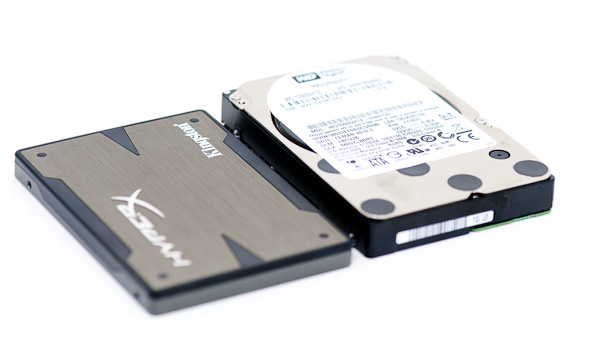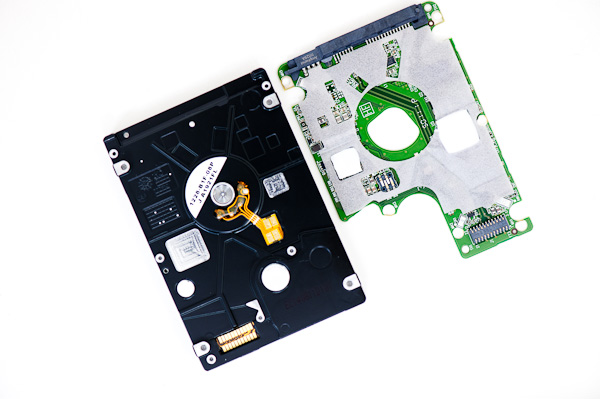Western Digital VelociRaptor 1TB (WD1000DHTZ) Review
by Anand Lal Shimpi on April 16, 2012 8:00 AM EST- Posted in
- Storage
- HDDs
- Western Digital
- VelociRaptor
Final Words
The new VelociRaptor does reclaim its title as world's fastest client hard drive, and I do appreciate the fact that WD hasn't raised prices on the drive in the past two years either. Compared to any 3.5" drive on the market today, the new VR is significantly faster without a doubt. Random IO performance is at least double most 3.5" drives, and sequential performance is almost 50% better than the fastest competitors. Most impressive is the fact that power consumption is actually competitive with modern 3.5" green drives as well, another benefit of the VR's 2.5" package.
The biggest problem for the new VR today is the same issue we had two years ago: SSDs are much faster, and are quickly becoming more affordable. As a primary drive I wouldn't recommend the VelociRaptor simply because you can get a better overall experience with an SSD. We have a number of very reliable, reasonably affordable (128GB), high-performing SSD options to choose from. Intel's lineup, Samsung's SSD 830 and Crucial's m4 all come to mind.
As secondary storage, the new VelociRaptor appeals to those users who need more capacity than an SSD can affordably offer, for active use. Launching applications, games, and working on (not just streaming for playback) large data files are all going to be quicker on the VR than on a standard 3.5" drive. If you're building the ultimate workstation, you could use an SSD + VR for internal storage coupled with some larger, slower drives in RAID as a backup or for your more passive data (movies, music, edited photos). For most users however, I'd honestly recommend an SSD plus a couple of large, 5400/7200RPM drives in RAID-1 for everything you can't store on your SSD. While the Raptor line was quickly embraced by the enthusiast, I believe it has transitioned exclusively to a workstation role.
I have to admit I was disappointed to see that Western Digital went conservative on the new VelociRaptor design and didn't include any on-board NAND to really mix things up. What I was hoping for was a combination of the VelociRaptor and Seagate's Momentus XT. Perhaps that doesn't make sense given the available SSD caching solutions available today, but I don't see the harm in pairing even a small amount of NAND with the drive. I don't see hard drives going away anytime soon, so we might as well try to make accessing them as quick as possible.
Then there's the extreme option. I would love to see a manufacturer treat a hard drive as an SSD with a mechanical counterpart, rather than a hard drive with some NAND on it. I'm curious to see what a VelociRaptor (or any other 2.5" HDD) with 64GB of NAND used as a read/write cache would behave like. If users are able to fit all of their program, apps and data into a 128GB SSD, I have to believe that a well managed cache can deliver compelling performance with half that space.
Unfortunately most hard drive companies seem slow to adopt NAND into their designs, so I suspect much of this will have to be a dream for now. The new VelociRaptor is a great evolution of the design and it's truly a very fast hard drive. Just as before, if I needed to buy a high-performance mechanical hard drive, it's the one I'd pick.












92 Comments
View All Comments
JarredWalton - Monday, April 16, 2012 - link
15K drives are exclusively SAS/SCSI, and capacities are lower than WD while prices are higher. In fact, the 15k drives are right in SSD territory for price per GB. Looking at Newegg, they range from as low as $1/GB to around $2.50/GB, with maximum capacity topping out at 600GB. A 512GB Crucial m4 will only cost around $550, for example. Still, for enterprise workloads you'd need an enterprise HDD most likely. Anyway, I've clarified the statement to say "mainstream 10k" -- we know 15k has been around for enterprise for ages. One might argue that the reason WD even came out with the Raptor is that they didn't have a 15k enterprise offering to protect.Sabresiberian - Monday, April 16, 2012 - link
Name them.The only 10-15k hard drives to exist before the VR were SAS drives; if you think these are expensive, check out the price of SAS drives. (They are quite a bit cheaper than they used to be, too.)
;)
jabber - Monday, April 16, 2012 - link
My old Mk2 75GB Raptor sit as the OS drive for my gaming rig. Noisy but still surprises me now and then.I have moved my Gf over to SSD tech but I haven't as yet. If I got SSD in one machine I'll want them in all my machines and I just cant afford that.
Would like to see some testing of this with a 40GB cache drive just for giggles.
Denithor - Monday, April 16, 2012 - link
Actually, this is a fantastic suggestion.Look at whether there's any advantage to a VR + 40GB cache SSD versus a typical 1TB 7200 with the same cache drive.
Golgatha - Monday, April 16, 2012 - link
2x500GB or 1TB in RAID0Faster, cheaper, but somewhat less reliable due to RAID0. If you have space for 2 drives, I think the RE4 line is a much, much better value.
marraco - Monday, April 16, 2012 - link
And a 100 Gb partition for OS would use the 5% faster sectors, which runs around 210 Mb/s (more than 400 Mb/s in RAID0). That partition would also be short stroked, so 4kb random should give good numbers for an HDDShadowmaster625 - Monday, April 16, 2012 - link
I dont care if it is just one 8GB MLC chip, with 67% of the chip reserved for wear leveling. Even just 2GB of flash would make the poor random I/O performance much more bearable, and bring this close to Momentus XT type performance.magreen - Monday, April 16, 2012 - link
"The advantage of the NAND equipped Seagate Momentus XT is just as large."That should read the "advantage over the NAND equipped...," correct? It seems to say the opposite of what you mean right now.
MrSpadge - Monday, April 16, 2012 - link
"If users are able to fit all of their program, apps and data into a 128GB SSD, I have to believe that a well managed cache can deliver compelling performance with half that space."It definitely does. Using an Agility 3 60 GB as cache with SRT.
sixmoon - Monday, April 16, 2012 - link
Hi, I enjoyed the review, I somehow got tired of all the SSD reviews lately. I somehow expected this drive was going to be compared with SSD's and this is fair, however if you compare it to the new generation of 3-4TB, this HDD really doesn't find its place anymore. It's more expensive and smaller, and in the HDD world, being smaller also affects performance.I find the new Hitachi 7k4000 drive to be on par with the new Velociraptor, take a look here: http://macperformanceguide.com/Storage-Drive-Hitac...